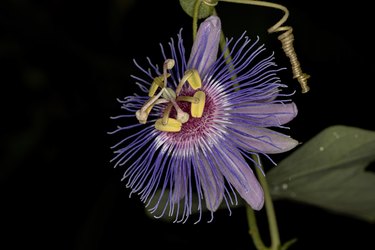
Grown for its flowers and fruit, the passion vine (Passiflora incarnata, USDA zones 5-9) is native to the southeastern United States, and it's also one of the flowering vines in Texas that grow well across this entire large state. The Texas A&M AgriLife Extension notes that its common name was given it by missionaries who thought parts of the vine's dramatic flowers symbolized the passion of the Christ. Its other common name of maypop is descriptive of how the vines "pop" out of the ground in May and how the large egg-shaped seedpods sound if you step on them, according to the North Carolina State Extension.
Other non-native passion vines that also grow well in Texas are the blue passionflower (Passiflora caerulea, zones 7-9) and the edible passionflower (Passiflora edulis, zones 10-12), both of which are native to South America. These two plants are not as cold-hardy as the native passion vine, which is a consideration for choosing a species that you can grow outdoors year-round as a perennial or just during the growing season as an annual. Regardless of species, these plants need the same growing conditions to prosper.
Video of the Day
Video of the Day
Step 1: Purchase a Healthy Plant
Shop for and purchase a healthy passion flower seedling with plenty of leaves on each vine. While passion vine can also be grown from seed, the seeds may take up to one year to germinate. Therefore, seedlings or more mature plants are recommended.
Step 2: Choose a Suitable Planting Site
Choose your planting location. Passion vines grow best in full to partial sun, on soil that has good drainage. Plant your vine near a fence or the side of your house for a little extra protection during the winter.
If you're growing a species that's not hardy in your growing zone, plant your passion vine in a pot so that you can bring it in during the coldest months.
Step 3: Dig a Hole and Plant
Dig a hole about two or three times bigger than the vine's root ball. Place the vine in the hole so that the top of the vine's soil is even with the ground. Fill in all around with the excavated garden soil. Tamp gently around the base of the vine.
Step 4: Provide Support for Climbing
Place a trellis or other climbing structure such as an arbor near the plant. These vines easily grow to 10 feet and often grow twice that length. If your vine is long enough, gently wrap a few tendrils around the trellis to encourage it to grow up the trellis.
Step 5: Keep Passion Vine Watered
Water thoroughly but do not let the vine sit for prolonged periods in water that does not drain. Water daily during the hottest months, if necessary.
Step 6: Fertilize Twice Yearly
Fertilize once in early spring and again in midsummer a water-soluble fertilizer labeled 10-5-20 or an organic equivalent.
Step 7: Prune Passion Vine
Cut your passion vine back when cold weather arrives. Apply a heavy layer of mulch at the base of the plant to help keep the roots warm. Give it some time in the spring, and it should grow anew once the weather warms.
If your passion vine is in a pot, bring it inside for the winter. Once you bring it in, you have two choices: either keep it in a bright window and allow it to continue growing, or let it go dormant and keep it in a dark room, giving it very little water.